Urban Green Fabric Analysis Promoting Sustainable Planning in Guatemala City
Abstract
1. Introduction
1.1. Urban Green
1.2. Urban Green Fabric of Guatemala City
2. Materials and Methods
2.1. Study Area
2.2. Methodological Approach
2.2.1. Urban Green Fabric Analysis
2.2.2. Spatial Pattern Characteristics of Urban Green Fabric
2.2.3. Citizens’ Interactions with the Urban Green Fabric
3. Results
3.1. Classification of Urban Green Fabric in Guatemala City
Land Cover and Land Use Map of Guatemala City
3.2. Urban Green Fabric Material Weft
3.2.1. Urban Green Spaces Spatial Pattern and Zones Ensembles
- Cluster 1: Scant, disaggregated, disconnected and heterogeneous green ensemble
- Cluster 2: Scant, aggregated, moderate connected and homogenous green ensemble
- Cluster 3: Scant, moderate aggregated, disconnected and moderate heterogeneous green ensemble
- Cluster 4: Scant, moderate clumped, disconnected and homogenous green ensemble
- Cluster 5: Abundant, moderate aggregated, disconnected and moderate heterogeneous green ensemble
- Cluster 6: Moderate abundant, aggregated, connected and homogenous green ensemble
3.2.2. Citizens’ Perceptions and Preferences on Urban Green Spaces
4. Discussion
4.1. Urban Green Fabric Analysis
4.1.1. Urban Land Cover and Urban Land Use of Guatemala City
4.1.2. Urban Green Spaces of Guatemala City
4.2. Urban Planning Implications of Green Fabric Analysis
4.2.1. Creation of New UGF Elements
4.2.2. Protection of UGF Elements
4.2.3. Enhancing the Mosaic of UGF
4.2.4. Urban Expansion and the Metropolitan Area
4.3. Uncertainties
5. Conclusions
Supplementary Materials
Author Contributions
Funding
Informed Consent Statement
Acknowledgments
Conflicts of Interest
References
- María, A.; Acero, J.L.; Aguilera, A.; García Lozano, M. Central America Urbanization Review. Making Cities Work for Central America. Directions in Development; World Bank: Washington, DC, USA, 2017; pp. 27–63. [Google Scholar] [CrossRef]
- United Nations, Department of Economic and Social Affairs, Population Division. World Urbanization Prospects: The 2018 Revision; (ST/ESA/SER.A/420); United Nations, Department of Economic and Social Affairs, Population Division: New York, NY, USA, 2018; 126p. [Google Scholar]
- Lungo, M. Ciudad grande, país pequeño: Los desafíos de la gestión metropolitana en. Centroamérica. In Repensando la experiencia urbana de América Latina: Cuestiones, Conceptos y Valores; Ribeiro, T., Ed.; CLACSO: Buenos Aires, Argentina, 2000; pp. 125–142. [Google Scholar]
- Aguilera, A. How Urbanization is transforming Central America. In Central America Urbanization Review. Making Cities Work for Central America; Maria, A., Aguilera, G., Eds.; World Bank Group: Washington, DC, USA, 2017; Chapter 1; pp. 27–64. [Google Scholar] [CrossRef]
- Calderón, R. Violence and social exclusion in urban contexts in Central America. In Social Theories of Urban Violence in the Global South. Toward Safe and Inclusive Cities; Salahub, J.E., Gottsbacher, M., De Boer, J., Eds.; Routledge: Abingdon, UK; New York, NY, USA, 2018; Chapter 6; pp. 99–120. [Google Scholar] [CrossRef]
- Gencer, E. An Overview of Urban Vulnerability to Natural Disaster and Climate Change in Central America & the Caribbean Region; Working Paper 78; Enrico Mattei Foundation: Milan, Italy, 2013; 25p. [Google Scholar] [CrossRef]
- ECLAC (Economic Commission for Latin America and the Caribbean). Climate Change in Central America: Potential Impacts and Public Policy Options (LC/MEX/L.1196/Rev.1); Central American Agricultural Council (CAC); Council of Ministers of Health of Central America (COMISCA); Central American Commission for Environment and Development (CCAD); Council of Ministers of Finance/Treasury of Central America and Dominic Republic (COSEFIN); Secretariat of Central American Economic Integration (SIECA); Central American Integration System (SICA); United Kingdom Department of International Development (UKAID); Danish International Development Agency (DANIDA); United Nations Publication: Mexico City, Mexico, 2015; 176p, Available online: https://repositorio.cepal.org/bitstream/handle/11362/39150/S1800827_en.pdf?sequence=7&isAllowed=y (accessed on 10 November 2020).
- Lungo, M. Expansión urbana y regulación de la tierra en Centroamérica: Antiguos problemas, nuevos desafíos. In El Rostro Urbano de América Latina; Ribeiro, T., Ed.; CLACSO: Buenos Aires, Argentina, 2003; pp. 257–272. [Google Scholar]
- Parnell, S.; Elmqvist, T.; McPhearson, T.; Nagendra, H.; Sörlin, S. Introduction: Situating knowledge and action for an urban planet. In The Urban Planet. Knowledge towards Sustainable Cities; Elmqvist, T., Bai, X., Frantzeskaki, N., Griffith, C., Maddox, D., McPhearson, T., Parnell, S., Romero-Lankao, P., Simons, D., Watkings, M., Eds.; Cambridge University Press: Cambridge, UK, 2018; pp. 1–16. [Google Scholar] [CrossRef]
- Taylor, L.; Hochuli, D.F. Defining greenspace: Multiple uses across multiple disciplines. Landsc. Urban Plan. 2017, 158, 25–38. [Google Scholar] [CrossRef]
- Gomez-Baggethun, E.; Gren, A.; Barton, D.; Langemeyer, J.; McPhearson, T.; O’Farrell, P.; Andersson, E.; Hamstead, Z.; Kremer, P. Urban ecosystem services. In Urbanization, Biodiversity, And Ecosystem Services: Challenges and Opportunities. A Global Assessment; Elmqvist, T., Fragkias, M., Goodness, J., Güneralp, B., Marcotulio, P., McDonald, R., Parnell, S., Schewenius, M., Sendstad, M., Seto, K., Wilkinson, C., Eds.; Springer: Dordrecht, The Netherlands, 2013; Chapter 11; pp. 175–251. [Google Scholar] [CrossRef]
- Benton-Short, L.; Keeley, M.; Rowland, J. Green infrastructure, green space, and sustainable urbanism: Geography’s important role. Urban Geogr. 2019, 40, 330–351. [Google Scholar] [CrossRef]
- Kim, J.; Kaplan, R. Physical and Psychological Factors in Sense of Community. Environ. Behav. 2004, 36, 313–340. [Google Scholar] [CrossRef]
- Wood, E.; Harsant, A.; Dallimer, M.; De Chavez, A.C.; McEachan, R.R.C.; Hassall, C. Not All Green Space Is Created Equal: Biodiversity Predicts Psychological Restorative Benefits from Urban Green Space. Front. Psychol. 2018, 9, 2320. [Google Scholar] [CrossRef]
- Jennings, V.; Bamkole, O. The Relationship between Social Cohesion and Urban Green Space: An Avenue for Health Promotion. Int. J. Environ. Res. Public Health 2019, 16, 452. [Google Scholar] [CrossRef]
- Wu, J.; Wang, M.; Li, W.; Peng, J.; Huang, L. Impact of Urban Green Space on Residential Housing Prices: Case Study in Shenzhen. J. Urban Plan. Dev. 2014, 141, 05014023. [Google Scholar] [CrossRef]
- Engström, G.; Gren, Å. Capturing the value of green space in urban parks in a sustainable urban planning and design context: Pros and cons of hedonic pricing. Ecol. Soc. 2017, 22, 21. [Google Scholar] [CrossRef]
- Bowler, D.E.; Buyung-Ali, L.; Knight, T.M.; Pullin, A.S. Urban greening to cool towns and cities: A systematic review of the empirical evidence. Landsc. Urban Plan. 2010, 97, 147–155. [Google Scholar] [CrossRef]
- Nowak, D.J.; Hirabayashi, S.; Doyle, M.; McGovern, M.; Pasher, J. Air pollution removal by urban forests in Canada and its effect on air quality and human health. Urban For. Urban Green. 2018, 29, 40–48. [Google Scholar] [CrossRef]
- Lindholm, G. The Implementation of Green Infrastructure: Relating a General Concept to Context and Site. Sustainability 2017, 9, 610. [Google Scholar] [CrossRef]
- Mell, I. Green infrastructure: Reflections on past, present and future praxis. Landsc. Res. 2017, 42, 135–145. [Google Scholar] [CrossRef]
- Finewood, M.H.; Matsler, A.M.; Zivkovich, J. Green Infrastructure and the Hidden Politics of Urban Stormwater Governance in a Postindustrial City. Ann. Am. Assoc. Geogr. 2019, 109, 909–925. [Google Scholar] [CrossRef]
- Ahern, J. Green infrastructure of cities: The spatial dimension. In Cities of the Future towards Integrated Sustainable Water and Landscape Management; Novotny, V., Brown, P., Eds.; IWA Publishing: London, UK, 2007; Chapter 17; pp. 267–283. [Google Scholar]
- Pauleit, S.; Ambrose, B.; Endersson, E.; Anton Buijs, A.; Haase, D.; Elands BHansen, R.; Kowarik, I.; Kronenburg, J.; Mattijssen, T.; Stahl, A.; et al. Advancing urban green infrastructure in Europe: Outcomes and reflections from the GREEN SURGE project. Urban For. Urban Green. 2019, 40, 4–16. [Google Scholar] [CrossRef]
- Benedict, M.A.; McMahon, E.T. Green Infrastructure: Linking Landscapes and Communities; Island Press: Washington, DC, USA, 2006; 320p. [Google Scholar]
- Larkin, B. The Politics and Poetics of Infrastructure. Annu. Rev. Anthr. 2013, 42, 327–343. [Google Scholar] [CrossRef]
- Lennon, M. Green infrastructure and planning policy: A critical assessment. Local Environ. 2015, 20, 957–980. [Google Scholar] [CrossRef]
- Evans, J. Ecology in the Urban Century: Power, Place and the Abstraction of Nature. In Grounding Urban Natures. Histories and Futures of Urban Ecologies; Ernstson, H., Sörlin, S., Eds.; MIT Press: Cambridge, MA, USA, 2019; pp. 303–322. [Google Scholar] [CrossRef]
- Allen, A. Peri-urbanization and the Political Ecology of Differential Sustainability. In A Routledge Handbook on Cities of the Global South; Parnell, S., Oldfeld, S., Eds.; Routledge: London, UK, 2014; pp. 522–538. [Google Scholar] [CrossRef]
- Smith, N. Uneven Development: Nature, Capital and the Production of Space; Blackwell: Oxford, UK, 1984; p. 344. [Google Scholar]
- Harvey, D. Justice, Nature and the Geography of Difference; Blackwell: Oxford, UK, 1996; p. 480. [Google Scholar]
- Wachsmuth, D.; Angelo, H. Green and Gray: New Ideologies of Nature in Urban Sustainability Policy. Ann. Am. Assoc. Geogr. 2018, 108, 1038–1056. [Google Scholar] [CrossRef]
- Davies, C.; Lafortezza, R. Urban Green infrastructure in Europe: Is grenspace planning and policy compliant? Land Use Policy 2017, 69, 93–101. [Google Scholar] [CrossRef]
- Gavrilidis, A.A.; Niță, M.R.; Onose, D.A.; Badiu, D.L.; Năstase, I.I. Methodological framework for urban sprawl control through sustainable planning of urban green infrastructure. Ecol. Indic. 2017, 96, 67–78. [Google Scholar] [CrossRef]
- Saaroni, H.; Amorim, J.; Hiemstra, J.; Pearlmutter, D. Urban Green Infrastructure as a tool for urban heat mitigation: Survey of research methodologies and findings across different climatic regions. Urban Clim. 2018, 24, 94–110. [Google Scholar] [CrossRef]
- Sturiale, L.; Scuderi, A. The role of Green infrastructures in Urban Planning for climate change adaptation. Climate 2019, 7, 119. [Google Scholar] [CrossRef]
- Tzoulas, K.; Korpela, K.; Venn, S.; Yli-Pelkonen, V.; Kaźmierczak, A.; Niemelä, J.; James, P. Promoting ecosystem and human health in urban areas using Green Infrastructure: A literature review. Landsc. Urban Plan. 2007, 81, 167–178. [Google Scholar] [CrossRef]
- Environmental Protection Agency—EPA. 2020. Available online: https://www.epa.gov/green-infrastructure/what-green-infrastructure (accessed on 10 November 2020).
- Breuste, J. The Green City: General Concept. In Making Green Cities; Breuste, J.H., Artmann, M., Ioja, C., Qureshi, S., Eds.; Springer: Cham, Swtizerland, 2020; Chapter 1; pp. 1–15. [Google Scholar]
- Gobierno de España. Estrategia Nacional de Infraestructura Verde y de la Conectividad y Restauración Ecológicas; Vicepresidencia Cuarta del Gobierno, Ministerio para la Transición Ecológica y el Reto Demográfico: Madrid, España, 2020; 250p, Available online: https://www.miteco.gob.es/es/biodiversidad/temas/ecosistemas-y-conectividad/conectividad-fragmentacion-de-habitats-y-restauracion/Infr_verde.aspx (accessed on 25 November 2020).
- Echavarría, M.; Zavala, P.; Coronel, L.; Montalvo, T.; Aguirre, L.M. Infraestructura Verde en el Sector de Agua Potable en América Latina y el Caribe: Tendencias, Retos y Oportunidades; ADERASA: Asunción, Paraguay; EcoDecision: Cumbayá, Ecuador; The Nature Conservancy: Arlington, VA, USA; Forest Trends: Washington DC, USA, 2015; 40p. [Google Scholar]
- Vásquez, A.L.; Giamnotti, E.; Galdámez, E.; Velásquez, P.; Devoto, C. Green Infrastructure planning to tackle Climate Change in Latin American Cities. In Urban Climates in Latin America; Henríquez, C., Romero, H., Eds.; Springer: Cham, Switzerland, 2019; Chapter 13; pp. 329–354. [Google Scholar] [CrossRef]
- Navarrete, D. Formas y conceptos de la urbanización planetaria para una lectura de la ciudad latinoamericana. Andamios 2013, 10, 69–90. [Google Scholar] [CrossRef]
- Cuervo, L.M. El Falso Espejo de la Ciudad Latinoamericana; Serie Gestión Pública No. 52; IILPES, CEPAL: Santiago, Chile, 2005; p. 43. Available online: https://www.cepal.org/ilpes/noticias/paginas/2/40352/FalsoEspejo-sgp52.pdf (accessed on 10 November 2020).
- Parker, J.; De Baro, M.E.Z. Green infrastructure in the Urban Environment: A systematic quantitative review. Sustainability 2019, 11, 3182. [Google Scholar] [CrossRef]
- Rojas, C.; Páez, A.; Barbosa, O.; Carrasco, J.A. Accessibility to urban green spaces in Chilean cities using adaptive thresholds. J. Transp. Geogr. 2016, 57, 227–240. [Google Scholar] [CrossRef]
- Macedo, S.S.; Queiroga, E.F.; Campos, A.C.; Galender, F.; Custódio, V. Os Sistemas de Espaços Livres e a Constituição da Esfera Pública Contemporânea no Brasil; EDUSP: Sao Paulo, Brazil, 2018; 415p. [Google Scholar]
- Cabrera, F.C.; Haase, D. Guatemala City: A socio-ecological profile. Cities 2018, 72, 379–390. [Google Scholar] [CrossRef]
- Brenner, M. Debating planetary urbanization: For an engaged pluralism. Environ. Plan. D Soc. Space 2018, 36, 570–590. [Google Scholar] [CrossRef]
- Lawhon, M.; Ernstson, H.; Silver, J. Provincializing Urban Political Ecology: Towards a Situated UPE through African Urbanism. Antipode 2014, 46, 497–516. [Google Scholar] [CrossRef]
- Ernstson, H.; Sörlin, S. (Eds.) Toward Comparative Urban Environmentalism: Situating Urban Natures in an Emerging “World of Cities”. In Grounding Urban Natures. Histories and Futures of Urban Ecologies; MIT Press: Cambridge, MA, USA, 2019; pp. 3–53. [Google Scholar] [CrossRef]
- Sheppard, E.; Leitner, H.; Maringanti, A. Provincializing Global Urbanism: A Manifesto. Urban Geogr. 2013, 34, 893–900. [Google Scholar] [CrossRef]
- Lawhon, M. Situated, Networked Environmentalisms: A Case for Environmental Theory from the South. Geogr. Compass 2013, 7, 128–138. [Google Scholar] [CrossRef]
- Dictionary of the Real Academy of the Spanish Language. Available online: https://dle.rae.es/ (accessed on 24 June 2020).
- Newman, P.; Kosonen, L.; Kenworthy, J. Theory of urban fabrics: Planning the walking, transit/public transport and automobile/motor car cities for reduced car dependency. Town Plan. Rev. 2016, 87, 429–458. [Google Scholar] [CrossRef]
- Duque, L.H. Mallas Urbanas Desplazadas; Editorial Pontificia Universidad Javeriana: Bogotá, Colombia, 2013; p. 141. [Google Scholar]
- Netto, V.M. The Social Fabric of Cities; Routledge: London, UK, 2017; p. 250. [Google Scholar] [CrossRef]
- MCC—Metrópolis Central Colaborativa. El tejido verdeazul metropolitano. In Reflexiones Sobre la Red de Infraestructuras Ambientales y su Papel en el Ordenamiento Territorial de la Metrópolis Central de la Ciudad de Guatemala; FUNDAECO: Ciudad de Guatemala, Guatemala; Apoyo Urbano: Ciudad de Guatemala, Guatemala; Municipalidad de Guatemala: Ciudad de Guatemala, Guatemala, 2019; p. 59. [Google Scholar]
- Feltynowski, M.; Kronenberg, J.; Bergier, T.; Kabisch, N.; Łaszkiewicz, E.; Strohbach, M.W. Challenges of urban green space management in the face of using inadequate data. Urban For. Urban Green. 2018, 31, 56–66. [Google Scholar] [CrossRef]
- Thomas, N.; Hendrix, C.; Congalton, R.G. A comparison of urban mapping methods using high-resolution digital imagery. Photogramm. Eng. Remote Sens. 2003, 69, 963–972. [Google Scholar] [CrossRef]
- Lambin, E.; Geist, H.; Rindfuss, R. (Eds.) Local Processes with Global Impacts. Introduction. In Land-Use and Land-Cover Change. Local Processes and Global Impacts; Springer: Heidelberg, Germany, 2006; Chapter 1; pp. 1–8. [Google Scholar] [CrossRef]
- Dennis, M.; Barlow, D.; Cavan, G.; Cook, P.A.; Gilchrist, A.; Handley, J.; James, P.; Thompson, J.; Tzoulas, K.; Wheater, C.P.; et al. Mapping Urban Green Infrastructure: A novel Landscape-Based approach to incorporating Land Use and Land Cover in the mapping of human-dominated systems. Land 2018, 7, 17. [Google Scholar] [CrossRef]
- Municipalidad de Guatemala. Memoria de Labores 2019 de la Dirección de Planificación Urbana; Municipalidad de Guatemala: Guatemala City, Guatemala, 2020; 51p.
- MAGA. Atlas Temático de la República de Guatemala; Serie Recursos Naturales, Amenazas y Vulnerabilidad; Ministerio de Agricultura, Ganadería y Alimentación, Gobierno de Guatemala: Guatemala City, Guatemala, 2005. [Google Scholar]
- Instituto Nacional de Estadística—INE. XII Censo Nacional de Población. Guatemala. 2020. Available online: www.ine.gob.gt (accessed on 24 May 2020).
- AVANCSO. El proceso de Desarrollo Metropolitano de la Ciudad de Guatemala; Cuadernos de Investigación No. 18; AVANCSO: Guatemala City, Guatemala, 2003; 308p. [Google Scholar]
- Martínez, F. El proceso de Urbanización en Guatemala. Un Enfoque Demográfico 1950–2002; CEUR; Universidad de San Carlos de Guatemala: Guatemala City, Guatemala, 2014; 266p. [Google Scholar]
- McHarg, I. Design with Nature, 25th Anniversary ed.; John Wiley & Sons: Hoboken, NJ, USA, 1995; 208p. [Google Scholar]
- DigitalGlobe®. The Benefits of the Eight Spectral Bands of WorldView-2; DigitalGlobe® White Papers; 2010; Available online: https://dg-cms-uploads-production.s3.amazonaws.com/uploads/document/file/35/DG-8SPECTRAL-WP_0.pdf (accessed on 26 January 2018).
- Small, C.; Okujeni, A.; van der Linden, S.; Waske, B. Remote Sensing of Urban Environments. In Comprehensive Remote Sensing; Liang, S., Ed.; Elsevier: Oxford, UK, 2018; Volume 6, Chapter 6; pp. 96–127. [Google Scholar]
- Breiman, L. Random Forests. Mach. Learn. 2001, 45, 5–32. [Google Scholar] [CrossRef]
- Pal, M. Random forest classifier for remote sensing classification. Int. J. Remote Sens. 2005, 26, 217–222. [Google Scholar] [CrossRef]
- Carlson, T.N.; Ripley, D.A. On the relation between NDVI, fractional vegetation cover, and leaf area index. Remote Sens. Environ. 1997, 62, 241–252. [Google Scholar] [CrossRef]
- Huete Alfredo, R. A soil-adjusted vegetation index (SAVI). Remote Sens. Environ. 1988, 25, 295–309. [Google Scholar] [CrossRef]
- Xu, H. Extraction of urban built-up land features from Landsat imagery using a thematic oriented index combination technique. Photogramm. Eng. Remote. Sens. 2007, 73, 1381–1391. [Google Scholar] [CrossRef]
- Fernández, I.C.; Wu, J.; Simonetti, J.A. The urban matrix matters: Quantifying the effects of surrounding urban vegetation on natural habitat remnants in Santiago de Chile. Landsc. Urban Plan. 2019, 187, 181–190. [Google Scholar] [CrossRef]
- Van Der Linden, S.; Rabe, A.; Held, M.; Jakimow, B.; Leitão, P.J.; Okujeni, A.; Schwieder, M.; Suess, S.; Hostert, P. The EnMAP-Box—A toolbox and application programming interface for EnMAP data processing. Remote Sens. 2015, 7, 11249–11266. [Google Scholar] [CrossRef]
- Ballesteros-Olmo, J.; Morata Carrasco, A. Normas para la Clasificación de los Espacios Verdes; Editorial Universidad Politécnica de Valencia: Valencia, España, 2001; 193p. [Google Scholar]
- Stanley, B.W.; Stark, B.L.; Johnston, K.L.; Smith, M.E. Urban open spaces in historical perspective: A transdisciplinary typology and analysis. Urban Geogr. 2012, 33, 1089–1117. [Google Scholar] [CrossRef]
- Pauleit, S.; Hansen, R.; Lorance Roll, E.; Zölch, T.; Andersson, E.; Luz, A.K.; Szaraz, L.; Tosics, I.; Vierikko, K. Urban Landscapes and Green Infrastructure. In Oxford Research Encyclopedia of Environmental Science; Oxford University Press: Oxford, UK, 2017. [Google Scholar] [CrossRef]
- ESRI Inc. ArcGIS Desktop (Version 10.5); Software; Environmental Systems Research Institute: Redlands, CA, USA, 2016. [Google Scholar]
- Churchman, A. Disentangling the concept of Density. J. Plan. Lit. 1999, 13, 389–411. [Google Scholar] [CrossRef]
- Bourdic, L.; Salat, S.; Nowacki, C. Assessing cities: A new system of cross-scale spatial indicators. Build. Res. Inf. 2012, 40, 592–605. [Google Scholar] [CrossRef]
- Forman, R.T.T. Urban Ecology. Science of Cities; Cambridge University Press: Cambridge, UK, 2014; 462p. [Google Scholar]
- McGarigal, K.; Cushman, S.A.; Ene, E. FRAGSTATS v4: Spatial Pattern Analysis Program for Categorical and Continuous Maps. Computer Software Program Produced by the Authors at the University of Massachusetts, Amherst. 2012. Available online: http://www.umass.edu/landeco/research/fragstats/fragstats.htm) (accessed on 24 May 2020).
- Aguilera, F.; Valenzuela, L.M.; Botequilha-Leitão, A. Landscape metrics in the analysis of urban land use patterns: A case study in a Spanish metropolitan area. Landsc. Urban Plan. 2011, 99, 226–238. [Google Scholar] [CrossRef]
- Grafius, D.R.; Corstanje, R.; Harris, J.A. Linking ecosystem services, urban form and green space configuration using multivariate landscape metric analysis. Landsc. Ecol. 2018, 33, 557–573. [Google Scholar] [CrossRef] [PubMed]
- Mears, M.; Brindley, P.; Jorgensen, A.; Ersoy, E.; Maheswaran, R. Greenspace spatial characteristics and human health in an urban environment: An epidemiological study using landscape metrics in Sheffield, UK. Ecol. Indic. 2019, 106, 105464. [Google Scholar] [CrossRef]
- R Development Core Team. R: A Language and Environment for Statistical Computing; R Foundation for Statistical Computing: Vienna, Austria, 2008; ISBN 3-900051-07-0. Available online: http://www.R-project.org (accessed on 24 May 2020).
- FAO. Global Forest Resources Assessment 2020. In Terms and Definitions 2020; Forest Resources Assessment Working Paper 188; FAO: Rome, Italy, 2018; p. 32. [Google Scholar]
- Custodio, V. Reestruturação Técnico Produtiva, Forma Urbana e Espaços Livres. In Reflexoes Sobre Espacos Livres na Forma Urbana; Macedo, S., Custodio, V., Garcia, V., Eds.; Universidad de Sao Paulo: Sao Paulo, Brazil, 2018; pp. 55–64. [Google Scholar]
- Farahani, L.M.; Maller, C.J. Perceptions and Preferences of Urban Greenspaces: A Literature Review and Framework for Policy and Practice. Landsc. Online 2018, 61, 1–22. [Google Scholar] [CrossRef]
- Instituto Nacional de Estadística—INE. XI Censo Nacional de Población y VI de Habitación; INE: Ciudad de Guatemala, Guatemala, 2003.
- VERBI Software. MAXQDA 2020 [Computer Software]; VERBI Software: Berlin, Germany, 2019; Available online: maxqda.com (accessed on 24 May 2020).
- Alvarez, I.; Gallo, B.; Garcon, E.A.; Oshiro, O. Street Tree Inventory of Campinas, Brazil: An Instrument for Urban Forestry Management and Planning. AUF 2015, 41, 233–244. [Google Scholar]
- Rodriguez-Galiano, V.; Ghimire, B.; Rogan, J.; Chicaolmo, M.; Rigol-Sanchez, J. An assessment of the effectiveness of a random forest classifier for land-cover classification. ISPRS J. Photogramm. Remote Sens. 2012, 67, 93–104. [Google Scholar] [CrossRef]
- Maxwell, A.E.; Warner, T.A.; Fang, F. Implementation of machine-learning classification in remote sensing: An applied review. Int. J. Remote Sens. 2018, 39, 2784–2817. [Google Scholar] [CrossRef]
- Long, Y.; Liu, L. How green are the streets? An analysis for central areas of Chinese cities using Tencent Street View. PLoS ONE 2017, 12, e0171110. [Google Scholar] [CrossRef] [PubMed]
- Wu, J.; Feng, Z.; Peng, Y.; Liu, Q.; He, Q. Neglected green street landscapes: A re-evaluation method of green justice. Urban For. Urban Green. 2019, 41, 344–353. [Google Scholar] [CrossRef]
- Valladares, R. Infraestructura vial, Barreras naturales y población: Municipio de Guatemala 1994–2005. In El Crecimiento de la Ciudad de Guatemala 1944–2005; Valladares, R., Morán, A., Eds.; Centro de Estudios Urbanos y Regionales, Universidad de San Carlos: San Carlos, CA, USA, 2006; pp. 29–181. [Google Scholar]
- Gellert, G. Ciudad de Guatemala: Factores determinantes en su desarrollo urbano (1775 hasta la actualidad). Mesoamérica 1994, 27, 1–68. [Google Scholar]
- Municipalidad de Guatemala. Plan de Ordenamiento Territorial. In Municipal Resolution 30-2008 of the Municipal Council of Guatemala City; Municipalidad de Guatemala: Guatemala City, Guatemala, 2008. [Google Scholar]
- Municipalidad de Guatemala. EDOM 1972–2000. In Plan de Desarrollo Metropolitano; Dirección de Planificación, Municipalidad de Guatemala: Guatemala City, Guatemala, 1972; 398p. [Google Scholar]
- Dosal, P. The political economy of Guatemalan industrialization, 1871–1948: The career of Carlos P. Novella. Hisp. Am. Hist. Rev. 1988, 68, 321–358. [Google Scholar] [CrossRef][Green Version]
- GIMBOT. Mapa de Bosques y Uso de la Tierra 2012; El Grupo Interinstitucional de Monitoreo de Bosques y Uso de la Tierra—GIMBOT: Guatemala City, Guatemala, 2014. [Google Scholar]
- Brites, W.F. La ciudad en la encrucijada neoliberal. Urbanismo mercado-céntrico y desigualdad socio-espacial en América Latina. URBE Rev. Bras. Gest. Urbana 2017, 9, 573–586. [Google Scholar] [CrossRef]
- Irrazával, F. El Imaginario “Verde” y el Verde Urbano como instrumento de consumo Inmobiliario: Configurando las condiciones ambientales del Área Metropolitanad de Santiago. Revista INVI 2012, 15, 73–103. [Google Scholar] [CrossRef]
- Cabrera, M. Donde la ciudad pierde su esencia: Lucha de las clases medias por el espacio público y el derecho a la ciudad en Ciudad de Panamá. In El Derecho a la Ciudad en America Latina. Visiones Desde la Política; Carrion, F., Erazo, J., Eds.; UNAM: Ciudad de México, México; IDRC/CRDI: Ottawa, ON, Canada; CLACSO: Buenos Aires, Argentina, 2016; pp. 91–108. [Google Scholar]
- Bravo, M.A. Proceso de Urbanización, Segregación Social, Violencia Urbana y “Barrios Cerrados” en Guatemala 1944–2002; CEUR; Universidad de San Carlos: San Carlos, CA, USA, 2007; 231p. [Google Scholar]
- Kronenberg, J.; Haase, A.; Łaszkiewicz, E.; Antal, A.; Baravikova, A.; Biernacka, M.; Dushkova, D.; Filčak, R.; Haase, D.; Ignatieva, M.; et al. Environmental justice in the context of urban green space availability, accessibility, and attractiveness in postsocialist cities. Cities 2020, 106, 102862. [Google Scholar] [CrossRef]
- Procuraduría Ambiental y del Ordenamiento Territorial Del D.F.—PAOT. Presente y Futuro de las Áreas Verdes y del Arbolado de la Ciudad de México; Procuraduría Ambiental y del Ordenamiento Territorial Del D.F.—PAOT: Ciudad de México, México, 2010; p. 261.
- Escalante, A.; Grande, C. Análisis de estructuras verdes en la ciudad capital de El Salvador. In Proceedings of the XV Conferencia de Ordenamiento Territorial y Urbanismo, La Habana, Cuba, 9–13 November 2015. [Google Scholar]
- Municipality of San Jose—MSJ. Áreas Verdes, Deportivas y Recreativas del Cantón San José; Municipality of San Jose—MSJ: San José, Costa Rica, 2014; p. 40.
- Angel, S.; Bartley, K.; Derr, M.; Malur, A.; Mejía, J.; Nuka, P.; Perlin, M.; Sahai, S.; Torrens, M.; Vargas, M. Rapid Urbanization in Tegucigalpa, Honduras Preparing for the Doubling of the City’s Population in the Next Twenty-Five Years; Report; Woodrow Wilson School of Public and International Affairs, Princeton University: Princeton, NJ, USA, 2004; p. 74. [Google Scholar]
- Japan International Cooperation Agency—JICA. Proyecto del Plan Maestro para el Desarrollo Urbano del Municipio de Managua en la República de Nicaragua; Final Report; JICA: Tokyo, Japan, 2017; p. 472.
- Quesada, G.; Arias, J. Análisis Geográfico de la segregación socio-ambiental de la Ciudad de San José. Revista Geográfica América Central 2013, 51, 101–123. [Google Scholar]
- Pérez Paredes, E.; Martínez, M.C. La planeación de las áreas verdes como una expresión del derecho a la ciudad: Análisis de caso de Atizapán de Zaragoza, Estado de México. In El Derecho a la Ciudad en America Latina. Visiones Desde la Política; Carrion, F., Erazo, J., Eds.; UNAM: Mexico City, Mexico; IDRC/CRDI: Ottawa, ON, Canada; CLACSO: Buenos Aires, Argentina, 2016; pp. 431–450. [Google Scholar]
- Hernández-Moreno, A.; Reyes-Paecke, S. The effects of urban expansion on green infrastructure along an extended latitudinal gradient (23° S–45° S) in Chile over the last thirty years. Land Use Policy 2018, 79, 725–739. [Google Scholar] [CrossRef]
- Morán, A. Segregación, Vulnerabilidad y Exclusión Social en la Ciudad de Guatemala; CEUR, Universidad de San Carlos de Guatemala: Guatemala City, Guatemala, 2011; 160p. [Google Scholar]
- Sosa, C.M. Descripción de la infraestructura cultural y recreativa enl a ciudad del Distrito Central de Honduras. Revista Ciencias Espaciales 2012, 5, 34–46. [Google Scholar] [CrossRef]
- Municipality of Panamá—MUAP; Interamerican Development Bank—BID. Plan de Acción. Panamá Metropolitana. Sostenible, Humana y Global; Municipalidad de Panamá—MUPA: Ciudad de Panamá, Panamá; Banco Interamericano de Desarrollo—BID: Washington DC, USA, 2015; 288p. [Google Scholar]
- Mateo, J.M. El Medio Ambiente Urbano y La Sostenibilidad Ambiental desde una perspectiva espacial. El Cable Revista Arquitectura 2004, 3, 55–70. [Google Scholar]
- Anguelovsky, I.; Irazábal-Zurita, C.; Connolly, J. Grabbed Urban Landscapes: Socio-spatial. Tensions in Green Infrastructure Planning in Medellín. IJURR 2018, 43, 133–156. [Google Scholar] [CrossRef]
- Cámara, C. Las iniciativas de participación ciudadana en el urbanismo. El urbanismo participativo, una nueva forma de entender la ciudad y la ciudadanía en la configuración de espacios públicos. Revista Estudios Urbanos Ciencias Sociales 2014, 2, 19–32. [Google Scholar]
- Apud, A.; Faggian, R.; Sposito, V.; Martino, D. Suitability analysis and planning of Green infrastructure in Montevideo, Uruguay. Sustainability 2020, 12, 9683. [Google Scholar] [CrossRef]
- Reyes, J.A.; Villanueva, M.C.; Garcia, A. Green Areas and Environmental Justice: Toward the Urban Sustainability of León, Guanajuato. In Sustainable Development Research and Practice in Mexico and Selected Latin American Countries; Leal Filho, W., Noyola-Cherpitel, R., Medellín-Milán, P., Ruiz-Vargas, V., Eds.; World Sustainability Series; Springer: Cham, Switzerland, 2018. [Google Scholar] [CrossRef]
- Miller, R.; Hauer, R.; Werner, L. Urban Forestry. In Planning and Managing Urban Greenspaces, 3rd ed.; Waveland Press: Long Grove, IL, USA, 2015. [Google Scholar]
- Moreno-Mata, A. Urban Sprawl, Environmental Justice and Equity in the Access to Green Spaces in the Metropolitan Area of San Luis Potosí, Mexico. In Sustainable Development Research and Practice in Mexico and Selected Latin American Countries; Leal Filho, W., Noyola-Cherpitel, R., Medellín-Milán, P., Ruiz-Vargas, V., Eds.; World Sustainability Series; Springer: Cham, Switzerland, 2018. [Google Scholar] [CrossRef]
- Gill, S.E.; Handley, J.F.; Ennos, A.R.; Pauleit, S. Adapting cities for climate change: The role of green infrastructure. Built Environ. 2007, 33, 115–133. [Google Scholar] [CrossRef]
- Monterroso, R.; Villatoro, J.; Mazariegos, E. Análisis Estratégico de Potencialidad y Economía Territorial de los Barrancos del Municipio de Guatemala Como Herramienta para la Sostenibilidad en los Asentamientos Humanos; Final Report DIGI; USAC: Guatemala City, Guatemala, 2014. [Google Scholar]
- Lausch, A.; Schaepman, M.E.; Skidmore, A.K.; Truckenbrodt, S.C.; Hacker, J.M.; Baade, J.; Bannehr, L.; Borg, E.; Bumberger, J.; Dietrich, P.; et al. Linking the Remote Sensing of Geodiversity and Traits Relevant to Biodiversity—Part II: Geomorphology, Terrain and Surfaces. Remote Sens. 2020, 12, 3690. [Google Scholar] [CrossRef]
- Loram, A.; Tratalos, J.; Warren, P.H.; Gaston, K.J. Urban domestic gardens (X): The extent & structure of the resource in five major cities. Landsc. Ecol. 2007, 22, 601–615. [Google Scholar] [CrossRef]
- Farahani, L.M.; Maller, C.J.; Phelan, K. Private Gardens as Urban Greenspaces: Can They. Compensate for Poor Greenspace Access in Lower Socioeconomic Neighbourhoods? Landsc. Online 2018, 59, 1–18. [Google Scholar] [CrossRef]
- González-García, A.; Gómez, A. Private Urban Greenspaces or “Patios” as a Key Element. in the Urban Ecology of Tropical Central America. Hum. Ecol. 2008, 36, 291–300. [Google Scholar] [CrossRef]
- Cerdas, V.M.; Castro, L.P.; Vargas, M.R.; Rojas, T.B. Indicadores ambientales de áreas verdes urbanas para la gestión en dos ciudades de Costa Rica. Revista Biología Tropical 2018, 66, 1421–1435. [Google Scholar] [CrossRef]
- BID—Interamerican Development Bank. Estudios Base para Ciudad de Panamá. Estudio de Crecimiento Urbano; Municipalidad de Panamá—MUPA: Ciudad de Panamá, Panamá; Banco Interamericano de Desarrollo—BID: Washington DC, USA, 2016; 288p. [Google Scholar]
- Haase, D.; Jänicke, C.; Wellmann, T. Front and back yard green analysis with subpixel vegetation fractions from earth observation data in a city. Landsc. Urban Plan. 2019, 182, 44–54. [Google Scholar] [CrossRef]
- FAO. Growing Greener Cities in Latin America and the Caribbean; FAO Report on Urban and Peri-Urban Agriculture in the Region; FAO: Rome, Italy, 2014; 51p. [Google Scholar]
- Thomson, G.; Newman, P. Urban fabrics and urban metabolism—From sustainable to regenerative cities. Resour. Conserv. Recycl. 2018, 132, 218–229. [Google Scholar] [CrossRef]
- Alvarado, L. El proceso de urbanización en Guatemala; Centro de Estudios Urbanos—CEUR, Universidad de San Carlos de Guatemala: Guatemala City, Guatemala, 1983; 35p. [Google Scholar]
- CEUR. Gestión Metropolitana. In Un Acercamiento a las Problemáticas Municipales de la Nueva Guatemala de la Asunción, Quetzaltenango y La Antigua Guatemala; Universidad de San Carlos de Guatemala: Guatemala City, Guatemala, 2012; pp. 25–103. [Google Scholar]
- Verdú-Vázquez, A.; Fernández-Pablos, E.; Lozano-Diez, R.V.; López-Zaldívar, Ó. Green space networks as natural infrastructures in peri-urban areas. Urban Ecosyst. 2020, 1–18. [Google Scholar] [CrossRef] [PubMed]
- Wellmann, T.; Lausch, A.; Andersson, E.; Knapp, S.; Cortinovis, C.; Jache, J.; Scheuer, S.; Kremer, P.; Mascarenhas, A.; Kraemer, R.; et al. Remote sensing in urban planning: Contributions towards ecologically sound policies? Landsc. Urban Plan. 2020, 204, 103921. [Google Scholar] [CrossRef]
- Vásquez, A. Infraestructura verde, servicios ecosistémicos y sus aportes para enfrentar el cambio climático en ciudades: El caso del corredor ribereño del río Mapocho en Santiago de Chile. Revista Geografía Norte Grande 2016, 63, 63–86. [Google Scholar] [CrossRef]
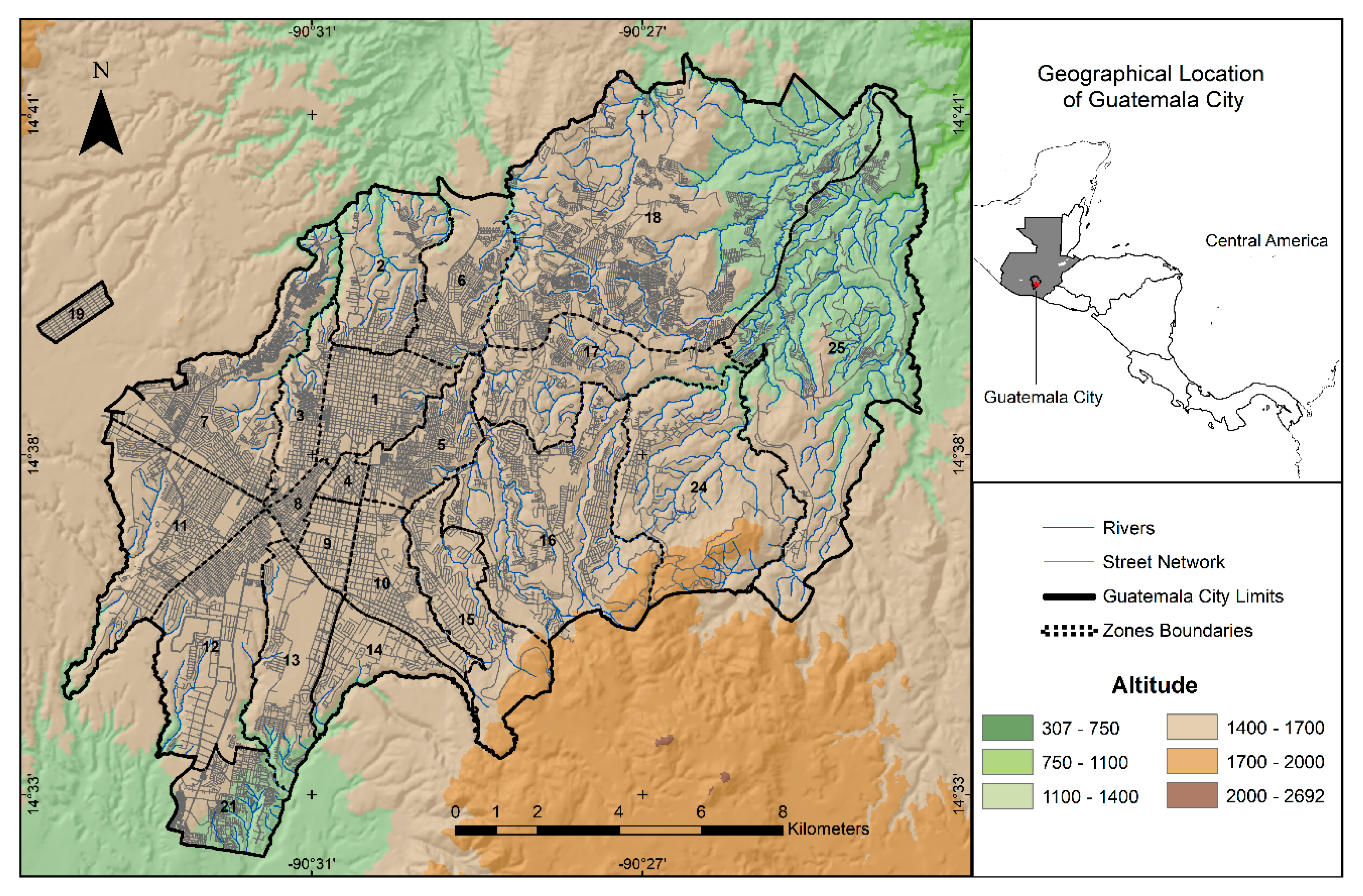
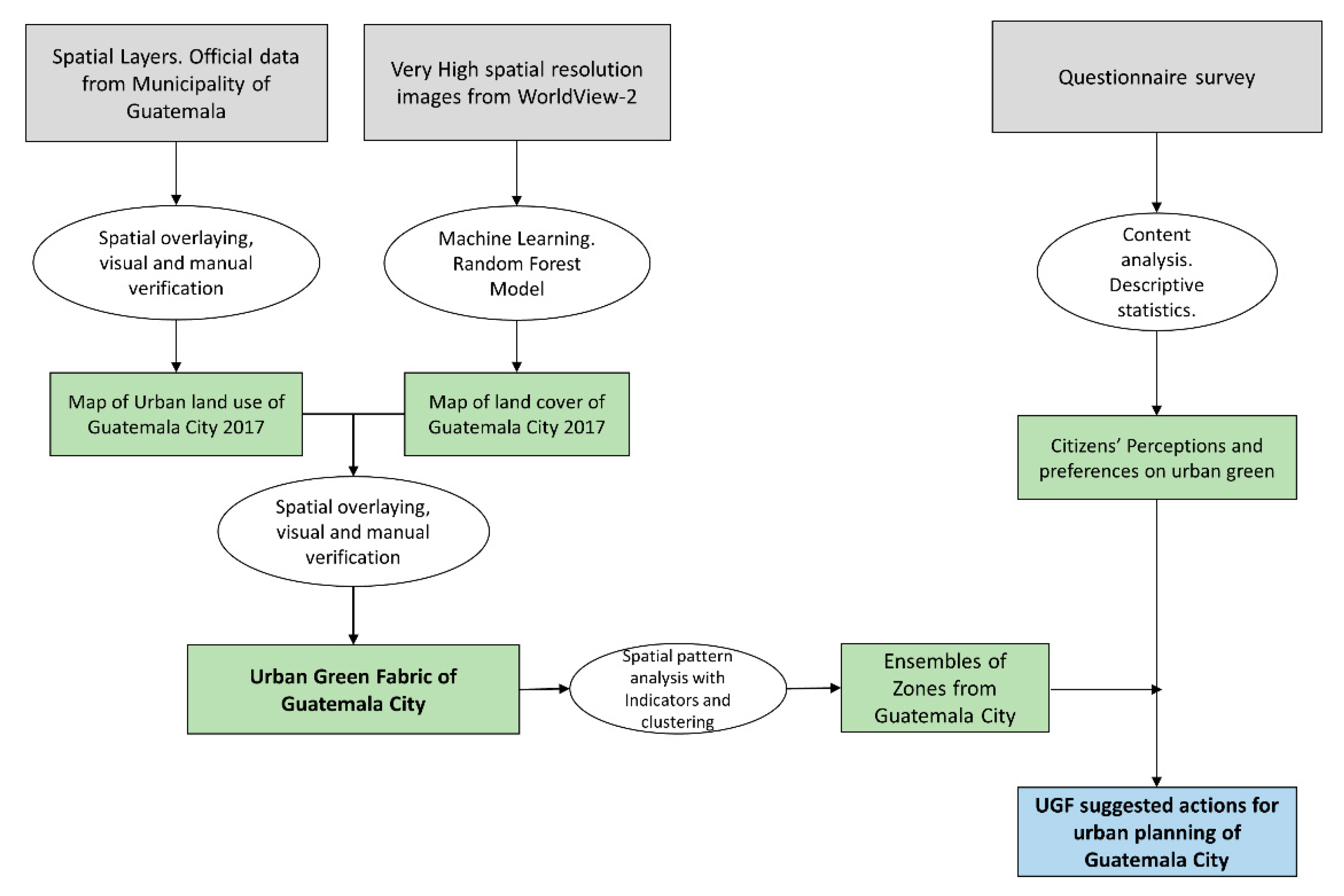
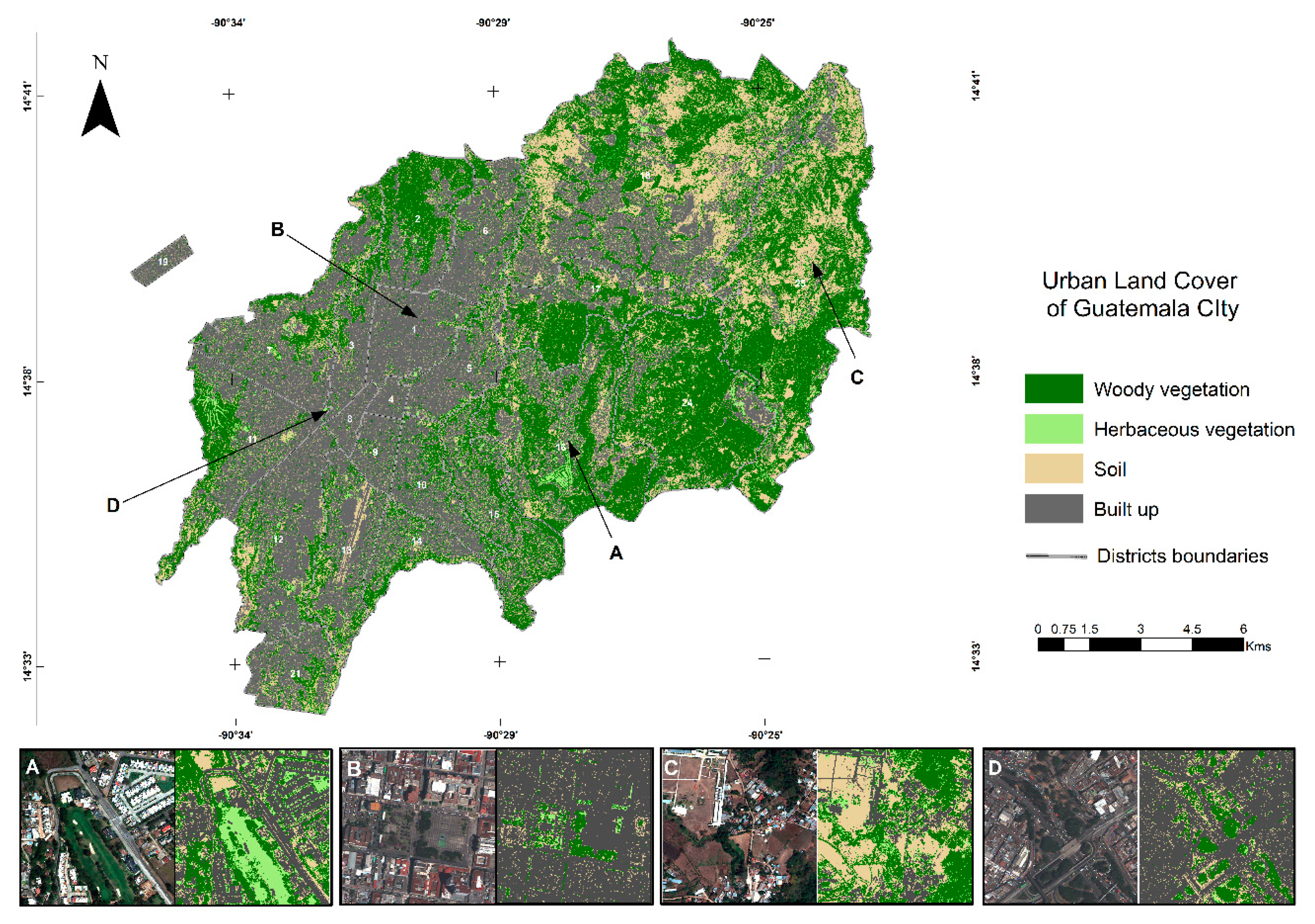
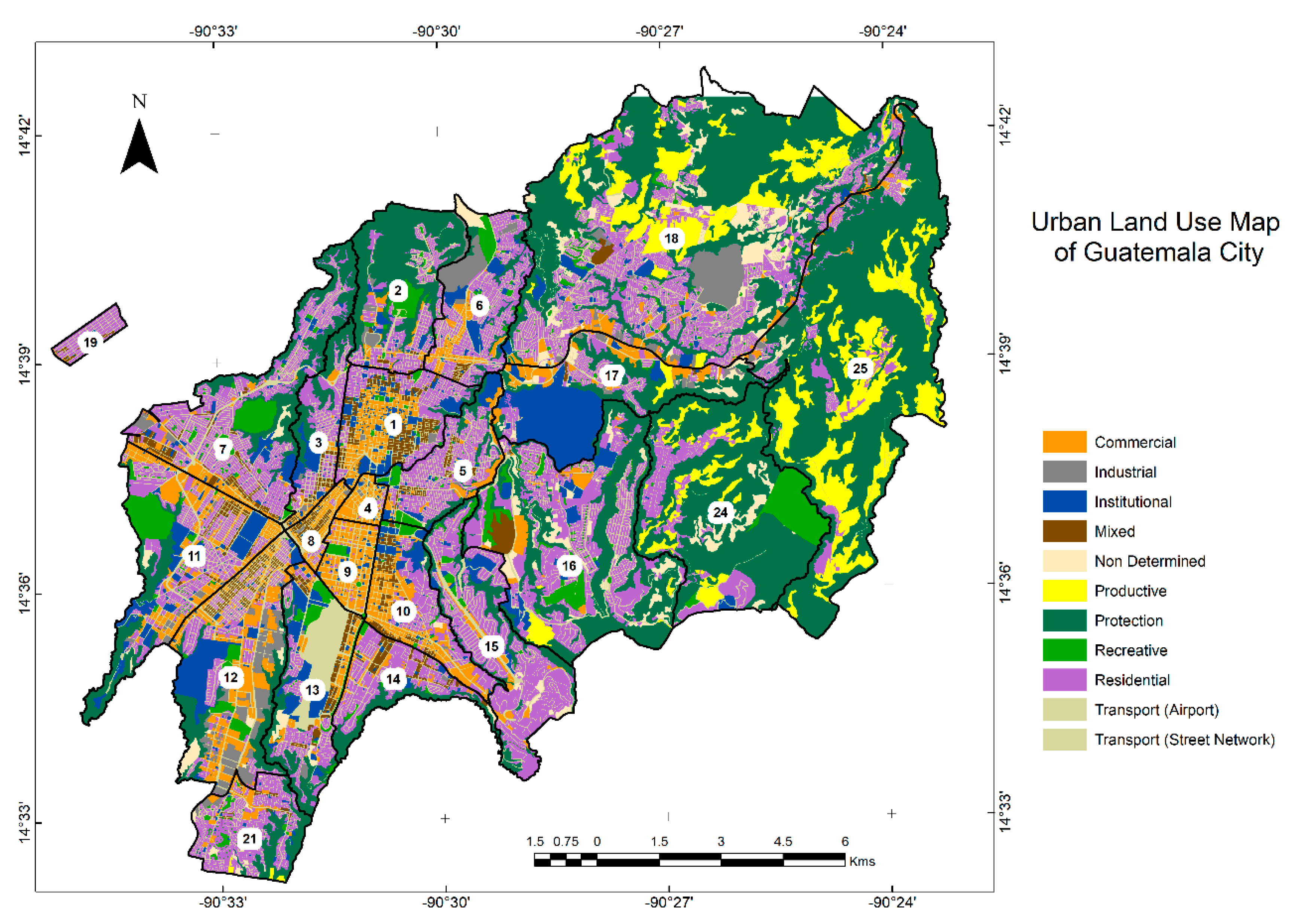
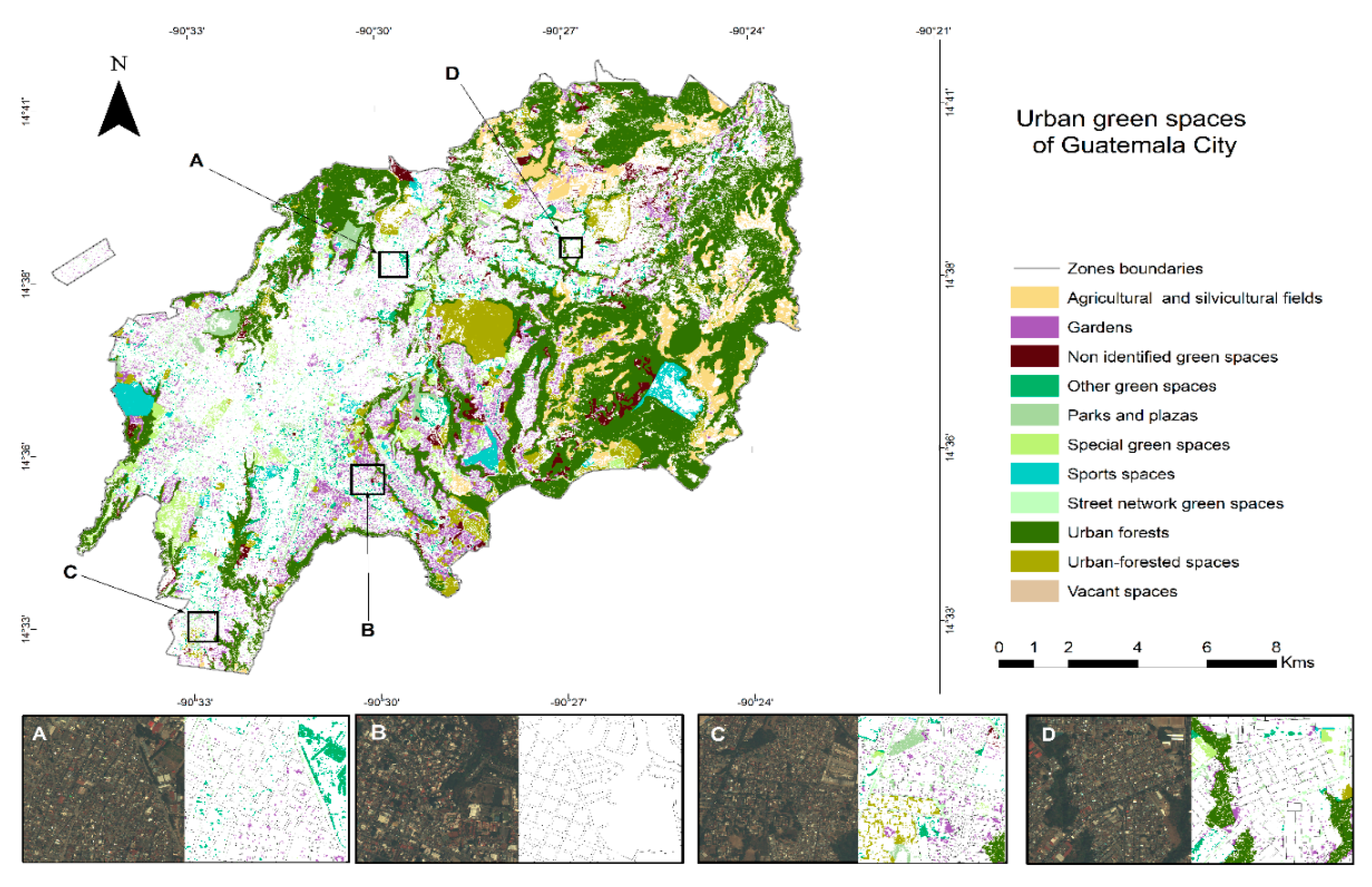

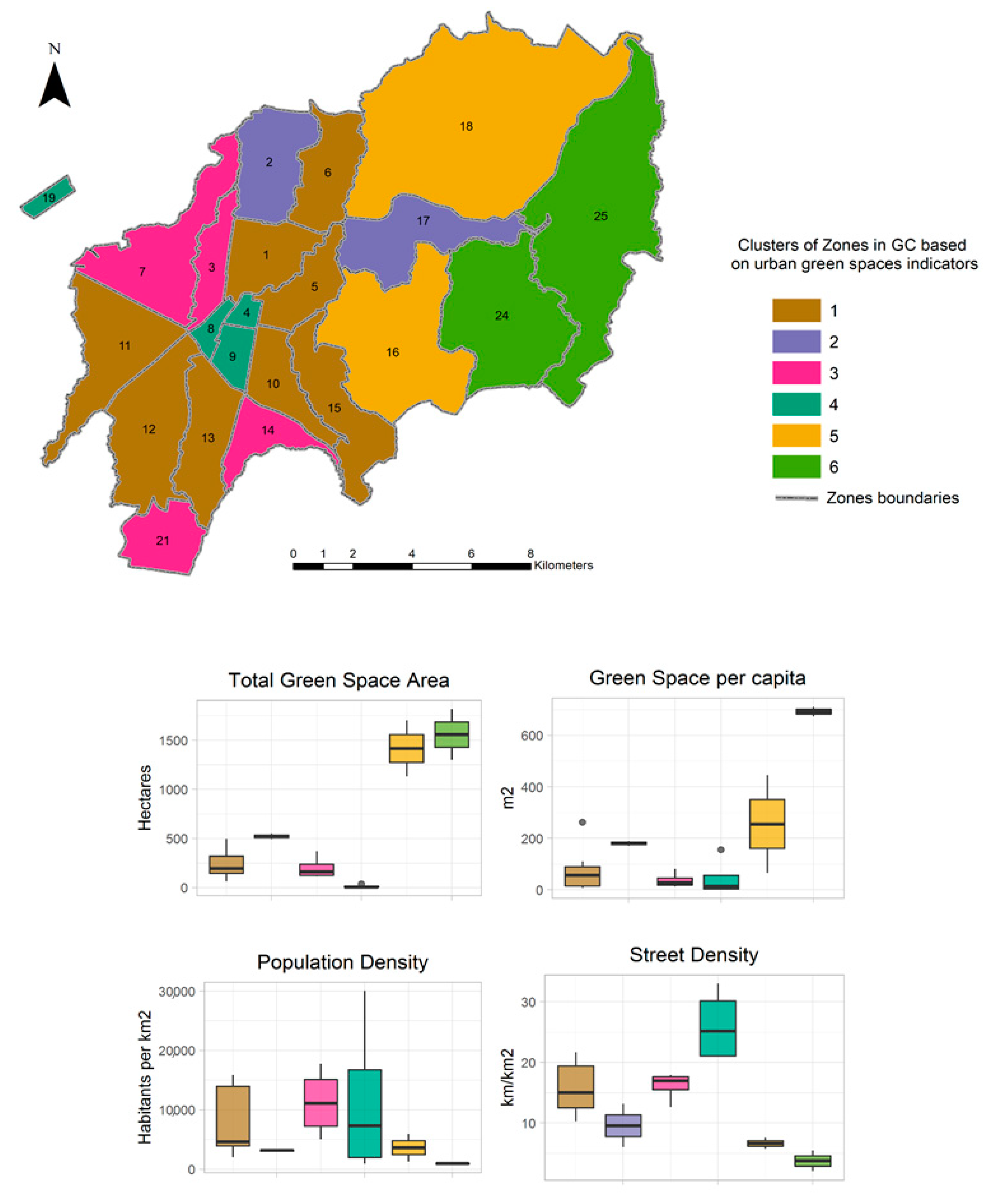
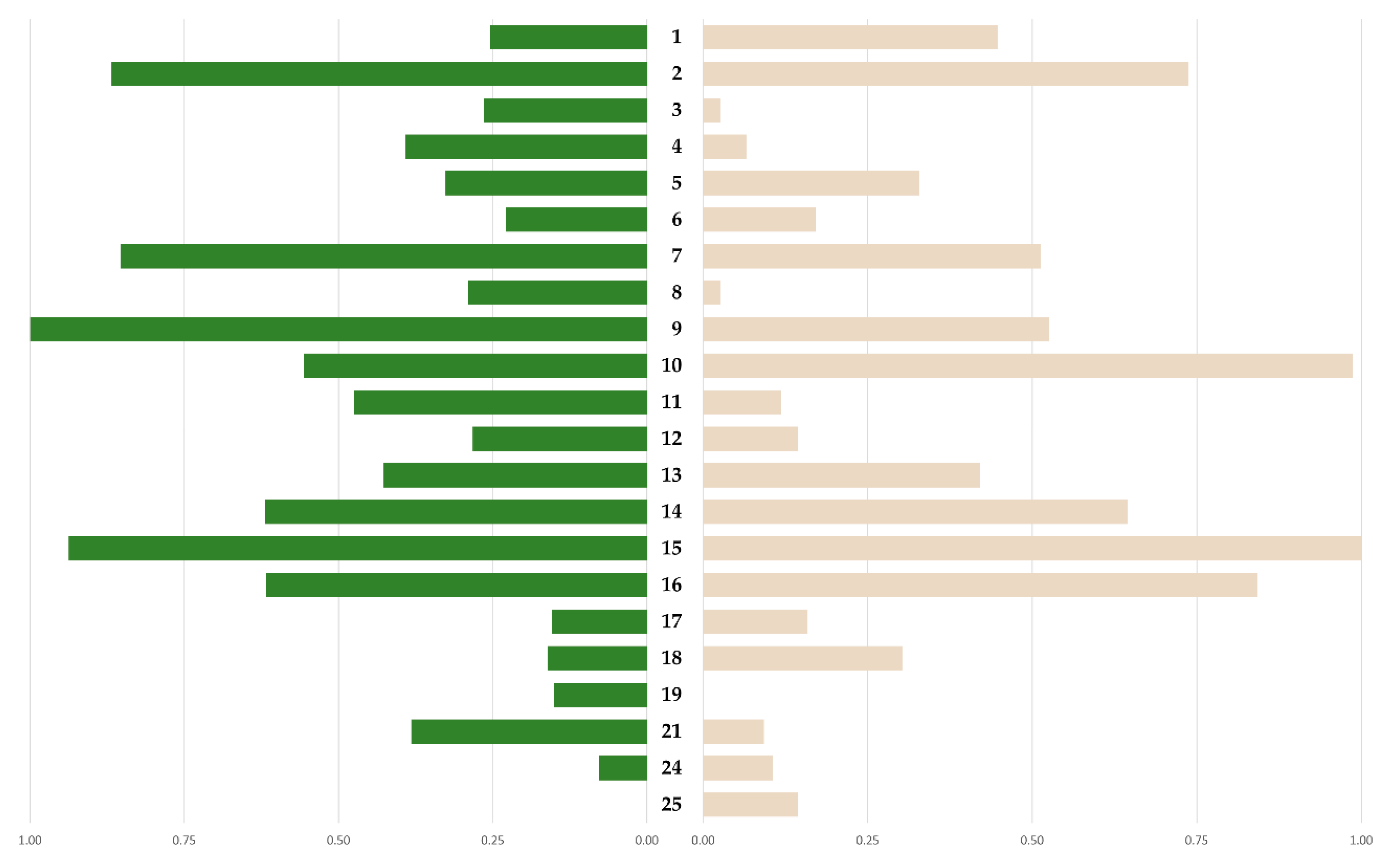
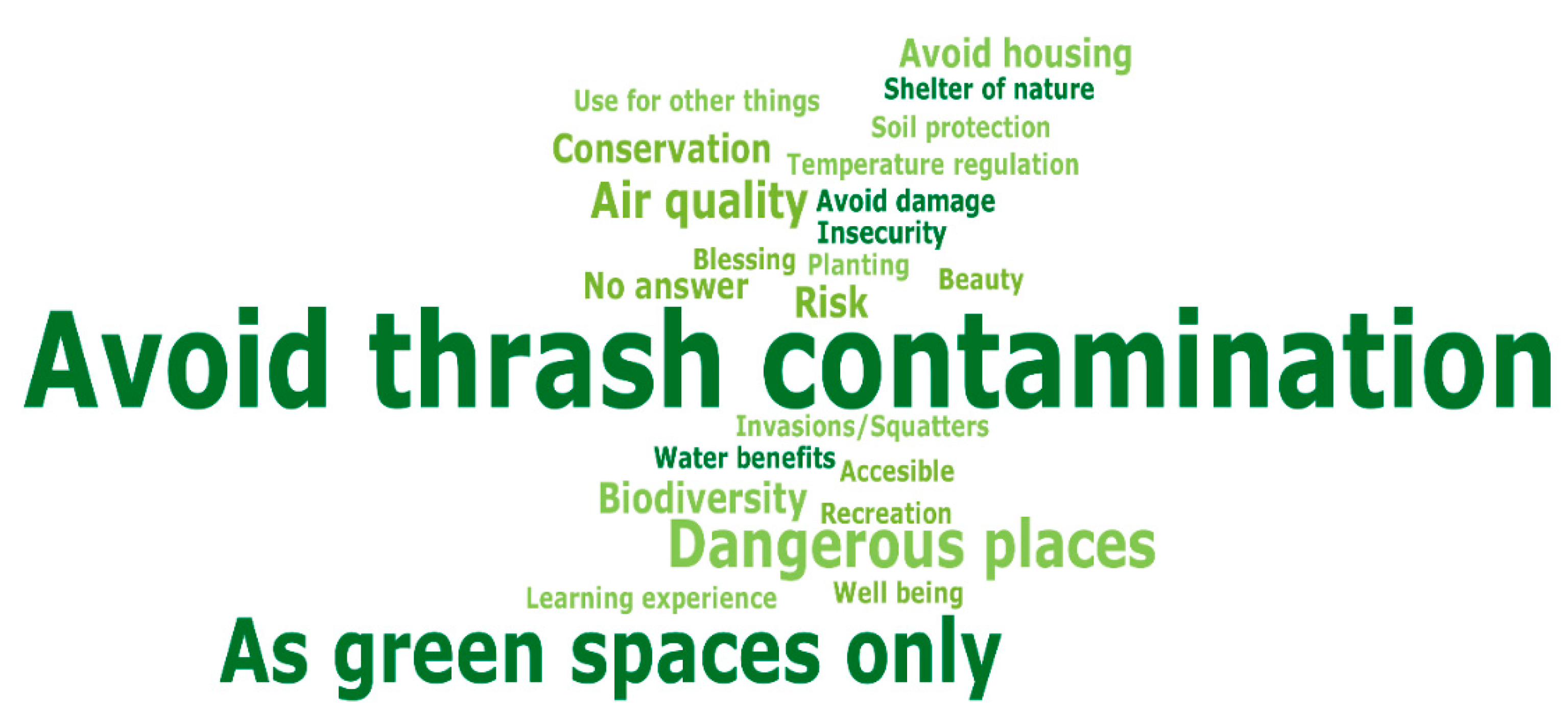
| Types | Description |
|---|---|
| Urban forests | Usually located in the municipal green belt on the ravines. Have a continuous cover of trees and shrubs. Include secondary succession. Can be private or public spaces. FAO conditions for forest were followed [90]. |
| Urban-forested spaces | Remnants of natural tree cover or designed cover with trees. Can be present in different urban land uses and built-up areas but not inside ravines boundaries. Can be private or public. FAO conditions for forest were followed [90]. |
| Urban wetlands | Spaces with permanent water or prone to flooding with natural vegetation. Usually near rivers, lakes, lagoons and deltas. Includes spaces in peri-urban areas also. They are mainly public. |
| Agricultural and silvicultural fields | Spaces with a prevalence of soil cover/grass cover [also some tree/shrub cover] and mainly used for different type of agriculture, animal husbandry and forest plantations. Predominantly private spaces. |
| Vacant spaces | Spaces with vegetation/soil cover mixing. Present in abandoned lots or not yet built. Commonly near built-up areas and in different urban land uses. Mainly private. |
| Street network green spaces | Spaces with tree/shrub/herbaceous vegetation cover in street network elements. These green spaces include single trees, aligned street trees, flowerbeds, spontaneous vegetation and so forth. Mainly public spaces |
| Gardens | Spaces with mixed vegetation cover in residential, commercial, mixed and institutional areas [government spaces]. Mainly ornamental or managed vegetation. Includes courtyards, front yards, backyards and lawns. Can be private and in less extent, public. |
| Parks and Squares | Spaces designated as such by the municipality. Found in any urban land use. Includes small [pocket], neighborhood and big [metropolitan] parks. Ecological and archaeological parks. Squares and Garden squares. Mainly public. |
| Sports spaces | Green spaces for physical activities. They include stadiums and fields for different sports. Elements of recreational land use. Can be private or public. |
| Special green spaces | Spaces with special function within institutional and recreational uses like Botanical and Zoological gardens, Amusement parks and Clubs. University campuses. Cemeteries. Include institutional spaces: Churchyards, Schoolyards. Health facilities green spaces. Public or private. |
| Vertical green spaces | Green facades, vertical gardens inside different type of buildings within different land uses. Mainly private spaces. Green walls or facades outside of buildings in both private and public spaces. |
| Other green spaces | Includes gardened spaces like small squares, accompanying green and similar. Usually of small to medium size, rarely large. Found in different land uses. Mainly private and some public. |
| Non-determined green spaces | Green spaces with not enough information on urban land use plot for classification purposes. |
| Primary Land Use | Surface Area (ha) | % from Total City Area |
|---|---|---|
| Protection | 7677.1 | 33.63 |
| Residential | 5016.96 | 21.98 |
| Transport | 2850.85 | 12.5 |
| Productive | 1559.86 | 6.83 |
| Commercial | 1545.42 | 6.77 |
| Institutional | 1477.44 | 6.47 |
| Recreative | 903.57 | 3.96 |
| Non identified | 701.16 | 3.07 |
| Industrial | 588.81 | 2.58 |
| Mixed | 506.82 | 2.22 |
| Total | 22828.04 | 100 |
Publisher’s Note: MDPI stays neutral with regard to jurisdictional claims in published maps and institutional affiliations. |
© 2020 by the authors. Licensee MDPI, Basel, Switzerland. This article is an open access article distributed under the terms and conditions of the Creative Commons Attribution (CC BY) license (http://creativecommons.org/licenses/by/4.0/).
Share and Cite
Castillo-Cabrera, F.; Wellmann, T.; Haase, D. Urban Green Fabric Analysis Promoting Sustainable Planning in Guatemala City. Land 2021, 10, 18. https://doi.org/10.3390/land10010018
Castillo-Cabrera F, Wellmann T, Haase D. Urban Green Fabric Analysis Promoting Sustainable Planning in Guatemala City. Land. 2021; 10(1):18. https://doi.org/10.3390/land10010018
Chicago/Turabian StyleCastillo-Cabrera, Fernando, Thilo Wellmann, and Dagmar Haase. 2021. "Urban Green Fabric Analysis Promoting Sustainable Planning in Guatemala City" Land 10, no. 1: 18. https://doi.org/10.3390/land10010018
APA StyleCastillo-Cabrera, F., Wellmann, T., & Haase, D. (2021). Urban Green Fabric Analysis Promoting Sustainable Planning in Guatemala City. Land, 10(1), 18. https://doi.org/10.3390/land10010018






